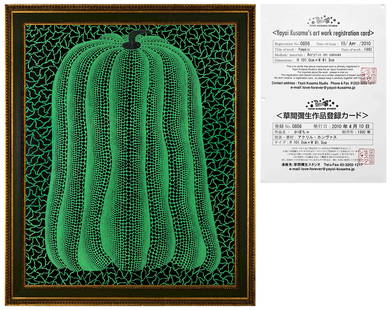

 Weekly: JewelryBonhamsSponsored.Your ad here?
Weekly: JewelryBonhamsSponsored.Your ad here?



Weekly: Jewelry
Bonhams
Sponsored.Your ad here?


 DesignChristie'sSponsored.Your ad here?
DesignChristie'sSponsored.Your ad here?



Design
Christie's
Sponsored.Your ad here?


 DesignChristie'sSponsored.Your ad here?
DesignChristie'sSponsored.Your ad here?



Design
Christie's
Sponsored.Your ad here?

YAYOI KUSAMA, Infinity Nets (T.W.A.), 2000
Similar Sale History
View More Items in PaintingsRelated Paintings
More Items in Paintings
View MoreRecommended Art
View More


Item Details
Description
Infinity Nets (T.W.A.), 2000
Acrylic on canvas. 76 1/4 x 102 in. (194 x 260 cm). Signed, titled and dated "Yayoi Kusama Infinity Nets (T.W.A.) 2000" on the reverse.
PROVENANCE OTA Fine Arts, Tokyo
With it's awe-inspiring expanse of white, labor-intensive intricate and hypnotizing monochrome thick brushstroke loop repetitions, the present lot is a mesmerizing composition from the artist's Infinity Nets; a series that has spanned almost all of the artist's career. Kusama has described obsession with the use of this pattern as a means of self-annihilation, however, her unceasing ability to create sublime beauty with this pattern is a re-affirmation of her persona. It has been said of many artists that they are inseparable from their work, but never has that been more literally and visually true than with Kusama. As the artist, who even often dresses herself to blend in to her paintings, has brought this intensely personal signature, which is linked to her very psychological make-up, to become "her alter ego, her logo, her franchise and her weapon of incursion into the world at large. The countless artworks that she has produced and that carry Kusama's nets into the world, when seen as a whole, are the mere results of a rigorously disciplined and single-minded performance that has lasted for almost fifty years," (L. Hoptman, Yayoi Kusama, London, 2000, p. 34). Yayoi Kusama was born in Matsumoto City, Japan in 1929 and she passed her crucial years of early adolescence while her country was at war. During this time. Kusama recollects experiencing her first hallucinations that have plagued her throughout her life. During these hallucinations Kusama sees the world broken up into patterns or completely covered in dots. Kusama credits these hallucinations as being a source for her artistic vision and the genesis of the Infinity Nets. Kusama was trained in Nihonga painting, a rigorous formal style developed during the Meiji period (1868-1912) that combines traditional Japanese techniques and materials with nineteenth century European representative subject matter. By 1950 she began to experiment with more abstracted natural forms and in the years that followed started to develop the patterns of the Infinity Nets from motifs based on natural observation into autonomous abstraction. Attracted by the experimental promise of the postwar international art scene, Kusama moved to New York City in 1958. As a young artist in New York, Kusama produced her first astonishing Infinity Net paintings, vast canvases entirely covered in rhythmic undulations of small, thickly painted loops, in 1959. The inherent philosophical paradox of these paintings—that "infinity" could be quantified and constrained within the arbitrary structure of a readymade canvas— combined with the more subjective and obsessional implications of their process, distinguish these works from Minimalist abstraction, which would dominate the New York art scene several years later. The mesmerizing, transcendent space of the Nets was further reinforced by Kusama's own insistent psychosomatic associations to her paintings. Kusama discusses the separation from her work to the other movements at the time of her development in an interview with Akira Tatehata: AK: Still, these works motivated by your interior necessity are considered to be precursors of Minimal and Pop Art. Although what people say may be of no concern to you, it is a fact in terms of chronology. YK: In 1960 one of my Infinity Nets paintings, Composition, 1959, was included in Udo Kultermann's exhibition 'Monochrome Maleriei' at the Städtisched Museum in Leverkusen, Germany. Mark Rothko and myself were the only two artists from America invited to paricipate. I made an inquiry as to why and how I was chosen and learned that the curator saw an article in Arts Magazine that discussed my work as black-andwhite painting. AK: You yourself did not think that you were making monochrome works? YK: No. People made it up after the fact. My Infinity Net paintings and Accumulation works had different origins from the European monochrome works. They were about an obsession: infinite repetition. In the 1960s, I said: 'I feel as if I were driving on the highways or carried on a conveyor belt without ending until my death. This is like continuing to drink thousands of cups of coffee or eating thousands of feet of macaroni… I am deeply terrified by the obsessions crawling over my body, whether they come from within me or from outside. I fluctuate between feelings of reality and unreality' AK: Your obsession with repetition signals both desire and the need to escape. However, you also added: 'In the gap between people and the strange jungle of civilized society lie many psychosomatic problems. I am deeply interested in the background of problems involved in the relationship of people and society. My artistic expressions always grow from the aggregation of these.' YK: Yes "Yayoi Kusama Akira Tatehata in conversation," Press Play: Contemporary Artists in Conversation, London, 2005, p. 426
Acrylic on canvas. 76 1/4 x 102 in. (194 x 260 cm). Signed, titled and dated "Yayoi Kusama Infinity Nets (T.W.A.) 2000" on the reverse.
PROVENANCE OTA Fine Arts, Tokyo
With it's awe-inspiring expanse of white, labor-intensive intricate and hypnotizing monochrome thick brushstroke loop repetitions, the present lot is a mesmerizing composition from the artist's Infinity Nets; a series that has spanned almost all of the artist's career. Kusama has described obsession with the use of this pattern as a means of self-annihilation, however, her unceasing ability to create sublime beauty with this pattern is a re-affirmation of her persona. It has been said of many artists that they are inseparable from their work, but never has that been more literally and visually true than with Kusama. As the artist, who even often dresses herself to blend in to her paintings, has brought this intensely personal signature, which is linked to her very psychological make-up, to become "her alter ego, her logo, her franchise and her weapon of incursion into the world at large. The countless artworks that she has produced and that carry Kusama's nets into the world, when seen as a whole, are the mere results of a rigorously disciplined and single-minded performance that has lasted for almost fifty years," (L. Hoptman, Yayoi Kusama, London, 2000, p. 34). Yayoi Kusama was born in Matsumoto City, Japan in 1929 and she passed her crucial years of early adolescence while her country was at war. During this time. Kusama recollects experiencing her first hallucinations that have plagued her throughout her life. During these hallucinations Kusama sees the world broken up into patterns or completely covered in dots. Kusama credits these hallucinations as being a source for her artistic vision and the genesis of the Infinity Nets. Kusama was trained in Nihonga painting, a rigorous formal style developed during the Meiji period (1868-1912) that combines traditional Japanese techniques and materials with nineteenth century European representative subject matter. By 1950 she began to experiment with more abstracted natural forms and in the years that followed started to develop the patterns of the Infinity Nets from motifs based on natural observation into autonomous abstraction. Attracted by the experimental promise of the postwar international art scene, Kusama moved to New York City in 1958. As a young artist in New York, Kusama produced her first astonishing Infinity Net paintings, vast canvases entirely covered in rhythmic undulations of small, thickly painted loops, in 1959. The inherent philosophical paradox of these paintings—that "infinity" could be quantified and constrained within the arbitrary structure of a readymade canvas— combined with the more subjective and obsessional implications of their process, distinguish these works from Minimalist abstraction, which would dominate the New York art scene several years later. The mesmerizing, transcendent space of the Nets was further reinforced by Kusama's own insistent psychosomatic associations to her paintings. Kusama discusses the separation from her work to the other movements at the time of her development in an interview with Akira Tatehata: AK: Still, these works motivated by your interior necessity are considered to be precursors of Minimal and Pop Art. Although what people say may be of no concern to you, it is a fact in terms of chronology. YK: In 1960 one of my Infinity Nets paintings, Composition, 1959, was included in Udo Kultermann's exhibition 'Monochrome Maleriei' at the Städtisched Museum in Leverkusen, Germany. Mark Rothko and myself were the only two artists from America invited to paricipate. I made an inquiry as to why and how I was chosen and learned that the curator saw an article in Arts Magazine that discussed my work as black-andwhite painting. AK: You yourself did not think that you were making monochrome works? YK: No. People made it up after the fact. My Infinity Net paintings and Accumulation works had different origins from the European monochrome works. They were about an obsession: infinite repetition. In the 1960s, I said: 'I feel as if I were driving on the highways or carried on a conveyor belt without ending until my death. This is like continuing to drink thousands of cups of coffee or eating thousands of feet of macaroni… I am deeply terrified by the obsessions crawling over my body, whether they come from within me or from outside. I fluctuate between feelings of reality and unreality' AK: Your obsession with repetition signals both desire and the need to escape. However, you also added: 'In the gap between people and the strange jungle of civilized society lie many psychosomatic problems. I am deeply interested in the background of problems involved in the relationship of people and society. My artistic expressions always grow from the aggregation of these.' YK: Yes "Yayoi Kusama Akira Tatehata in conversation," Press Play: Contemporary Artists in Conversation, London, 2005, p. 426
Buyer's Premium
- 25% up to $50,000.00
- 20% up to $1,000,000.00
- 12% above $1,000,000.00
YAYOI KUSAMA, Infinity Nets (T.W.A.), 2000
Estimate $300,000 - $400,000
2 bidders are watching this item.
Shipping & Pickup Options
Item located in New York, NY, usSee Policy for Shipping
Payment

TOP














![After Yayoi KUSAMA: Infinity Nets - Oil on Canvas: Homage after Yayoi Kusama three dimensional composition on canvas in gilt and black oil paints, spuriuosly signed and dated on back, 1991. [19 1/2" H x 16" W x 2" D].](https://p1.liveauctioneers.com/1221/264089/139027740_1_x.jpg?height=310&quality=70&version=1666729405)

![YAYOI KUSAMA OIL ON CANVAS INFINITY NETS FLOWER: YAYOI KUSAMA OIL ON CANVAS INFINITY NETS FLOWER. Canvas size 35.5cm by 30cm. Signed on the back. “Her expression transcends the question of whether [the art] is Oriental or American. Although it](https://p1.liveauctioneers.com/7947/270017/141272673_1_x.jpg?height=310&quality=70&version=1669339720)

![YAYOI KUSAMA OIL PAINTING ON CANVAS INFINITY NET FLOWER: YAYOI KUSAMA OIL PAINTING ON CANVAS INFINITY NET FLOWER. Image size 35cm by 30cm. Her expression transcends the question of whether [the art] is Oriental or American. Although it is something of both](https://p1.liveauctioneers.com/7947/279731/148051845_1_x.jpg?height=310&quality=70&version=1678060959)








![YAYOI KUSAMA OIL ON CANVAS HAT: YAYOI KUSAMA OIL ON CANVAS HAT. Image size 41cm by 32cm.With frame size 55cm by 44cm. “Her expression transcends the question of whether [the art] is Oriental or American. Although it is somethi](https://p1.liveauctioneers.com/7947/258275/134448812_1_x.jpg?height=310&quality=70&version=1660681007)



















![Emilio Grau-Sala "Sur la Plage" Oil on Canvas: Emilio Grau-Sala (Spanish, 1911-1975), "Sur la Plage" [On The Beach], Oil on Canvas, 1958, signed "Grau Sala" lower right, signed, inscribed "Trouville", dated, and titled to verso. Image: 21.5" H x 2](https://p1.liveauctioneers.com/5649/328023/176731071_1_x.jpg?height=310&quality=70&version=1714409606)














